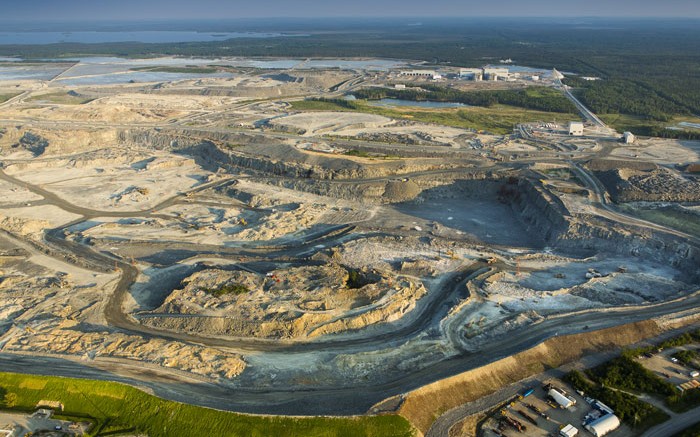Osisko Mining (TSX: OSK; US-OTC: OSKFF) has released third-quarter results that it believes should dispel any remaining doubts about its Canadian Malartic gold mine in Quebec.
“With the millionth ounce of gold production, we have proven beyond a doubt that Canadian Malartic is a solid producer,” president and CEO Sean Roosen said on a conference call.
Beyond the production milestone, the mine’s economics are improving with each quarter, and protecting the company from the severe effects of soft gold prices. Net earnings remained positive at $9.8 million or 2¢ per share, and while that was less than the 7¢ per share it reported for the same period last year, it shows that the mine can perform in a tough price environment.
Even more reflective of the mine reaching its potential are cash flows from operating activities, which are often considered a better gauge of a company’s economic health. Cash flows rang in at $70.7 million, beating last year’s tally of $55.8 million.
The lofty dollar sums came from the mine exceeding nameplate throughput of 54,000 tonnes per day. That helped Osisko record gold production of 120,208 oz., at operating cash costs of $754 per ounce.
Much of the reason for the good news was the mining fleet moving into the pit’s North zone. While drilling at the North wall is difficult because of its irregular surface — requiring smaller drills and the added cost of levelling the ground with tailings — the better grades and better recoveries at the mill are worth the effort.
And, as the pit deepens at the North wall, mining should become less complicated and costs should drop.
Roosen said that surface-mining costs are $3.50 to $4 per tonne. But with Osisko 80% finished building the second- and third-level benches, costs should fall into the $2.75- to $3.25-per-tonne range. At this time, the fourth bench and deeper costs fall into the $2.25 to $2.50 range.
As mining goes deeper, fragmentation also increases, which should make milling easier and more cost effective.
The company currently blends ore from near the surface of the north wall with lower-grade material.
“The best fragmentation we get is down in the fifth and sixth benches,” Roosen explains. “The first two to three benches don’t generate the fines we’d like to see.”
The North zone is providing 25–35% of the ore going to the mill.
Scotiabank analyst Leily Omoumi was impressed by the operating cash flows, especially in light of the “underwhelming” grade of 0.90 gram per tonne.
“We believe they did process 1 gram per tonne material in September, however it appears July and August were lower than we expected,” she wrote. “The key here is that access to the high-grade North zone gives them access to 1.2 gram-per-tonne-plus grades, and as the pit opens up this access is improving over time.”
Osisko reaffirmed production guidance of 485,000 oz. gold for the year. Omoumi says this means that grades will improve throughout the fourth quarter.
The company has produced 338,000 oz. gold so far, leaving a 147,000 oz. gap before reaching guidance.
To get there, Omoumi says it will have to continue at the 55,000-tonne-per-day clip, with online time at 92%, combined with an average grade of at least 1.10 grams per tonne.
Leily rates Osisko as “sector outperform,” with a $6.25-per-share target price.
On Nov. 8, Osisko’s stock was trading 6¢ higher at $4.57, on 3.08 million shares traded.
The reported $754 per oz. cash costs are an 11% improvement over last year, and the 54,000-tonne-per-day throughput represents a 25% increase over last year.
The mine’s production profile has also improved. Canadian Malartic has gone from producing 91,000 oz. gold in last year’s first quarter to the 120,000 oz. it produced in the most recent quarter.
On the financial side, Osisko’s vice-president and chief financial officer Bryan Coates heralded the company’s ability to renegotiate the terms on its $225-million, long-term debt.
Osisko extended principal repayment by one year, converted its variable interest rate to a fixed rate and reduced its overall interest charge on the debt.
“The take-away from this renegotiation is the confidence that our financial partners have in us,” Coates said. Those partners include the Canada Pension Plan and the Quebec government.
The quarter also saw its cash position grow by $16 million to $171.6 million, while debt was reduced by $9 million, “which demonstrates the cash-generating machine that Canadian Malartic is,” Coates said.
“With these large, open-pit mines, you’ve got to find them, build them, bring them up to nameplate capacity and capture whatever margins you can get from gold price,” Coates continued.
Another development for the mine, which sits on the southern end of the town of Malartic, is improved community relations, based on the company keeping the operation as quiet as possible.
“I think we’ve become a good neighbour in terms of our noise,” Roosen said. “It is probably the quietest mine in the world at this point, and companies from around the world come to see how we do it.”


Be the first to comment on "Osisko realizing Canadian Malartic’s potential"